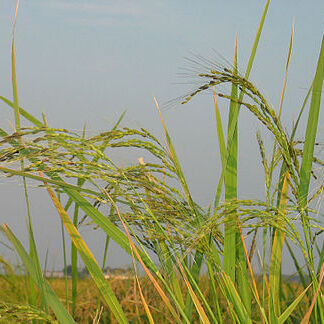Annual or perennial, tufted or shortly rhizomatous. Culms erect or ascending. Leaf blades mainly cauline, broadly linear, flat; ligule membranous, sometimes long. Inflorescence a panicle, usually many-spiculate, often nodding, lower branches usually whorled, unbranched or sparsely branched, pedicels short. Spikelets with 3 florets, 2 lower florets reduced, sterile, upper floret fertile, strongly laterally compressed, disarticulating below sterile lemmas, persistent in cultivated species; glumes vestigial, remaining after disarticulation as a shallow lobed frill at pedicel apex; sterile florets reduced to 2 narrow lemmas at base of fertile floret; fertile lemma boat-shaped, keeled, leathery, closely papillose, sometimes spinulose, infrequently smooth, prominently 5-veined, apex awnless to long awned; awn straight; palea resembling lemma but narrower, 3-veined, apex beaked. Stamens 6. Caryopsis variable in shape, embryo 1/4 length of caryopsis, hilum linear, as long as caryopsis. x = 12.
Erect annuals or perennials with flat leaf-blades and membranous ligules. Panicle open or rather dense; branches numerous, racemose with shortly pedicelled spikelets. Spikelets 3-flowered, strongly laterally compressed, falling entire from the pedicel; glumes absent or represented by obscure lips at the pedicel-tip; both lower florets represented only by narrow lemmas, these usually subulate or linear and much shorter than the spikelet. Upper floret hermaphrodite; lemma coriaceous, strongly keeled, prominently 5-nerved, with or without an awn; palea similar but narrower, keeled, 3-nerved; stamens 6; stigmas 2.
Spikelets 1-fld, articulated below the glumes, laterally compressed; glumes subequal, triangular-subulate, 1-veined, much shorter than the lemma; lemma narrowly oblong at anthesis, boat-shaped at maturity, acute, awned or awnless, 5-nerved, the lateral nerves near the involute margins; palea about equaling the lemma; plants of wet soil, with wide flat lvs and large open panicle. 25, trop.
Fertile lemmas 5-nerved (one pair of nerves very close to the margins), cymbiform, strongly keeled, coriaceous or rarely chartaceous, often tessellate or rugulose, usually awned, rarely awnless (in cultivated rice), usually with 2 short lateral protrusions at the apex; awn usually much longer than the spikelet, sometimes coloured, stiff or flexuous, often with a coloured basal callus.
Spikelets 1-flowered, disarticulating below the glumes, laterally compressed; glumes narrow, much shorter than the lemma (in our species); lemma indurate, rigid, keeled, 3-nerved, awned or sometimes awnless, sparsely to rather densely hispid; palea similar to the lemma but narrower and with no midnerve on the back, the two nerves close to the margins.
Palea slightly shorter than the lemma, of the same consistency and indument but with the margins hyaline, 3-(rarely 5-) nerved, awnless, obtuse or acute to acuminate, usually tightly clasped by the inflexed margins of the lemma.
Caryopsis (usually firmly enclosed by lemma and palea thus forming the “husk”), laterally compressed, oblong to oblong-elliptic in outline, whitish to brown or reddish; embryo very small; hilum large, linear.
Spikelets shortly pedicelled, 1-flowered, solitary, laterally strongly compressed, deciduous or (in cultivated rice) persistent, hermaphrodite; rhachilla articulating above the rudimentary glumes.
Sterile lemmas 2, subequal in shape and size, usually very small (nearly as long as the spikelet only in one sp. from S. America), faintly 1-nerved or nerveless.
Glumes 2, reduced to a narrow entire or 2-lobed rim, forming a cup-shaped cavity at the apex of the pedicel, whitish, green or reddish in colour.
Culms few-to many-noded, erect or ascending, sometimes floating, often spongy, usually hollow between the nodes.
Inflorescence an open or contracted panicle, many-flowered, erect or drooping.
Annual or perennial grasses, growing in a variety of moist habitats.
Ligule membranous, often lacerate, glabrous or pilose.
Lodicules 2, small, obovate or lanceolate-elliptic.
Stigmas pilose, large, laterally exserted.
Stamens 6, with the filaments free.
Ovary glabrous.

